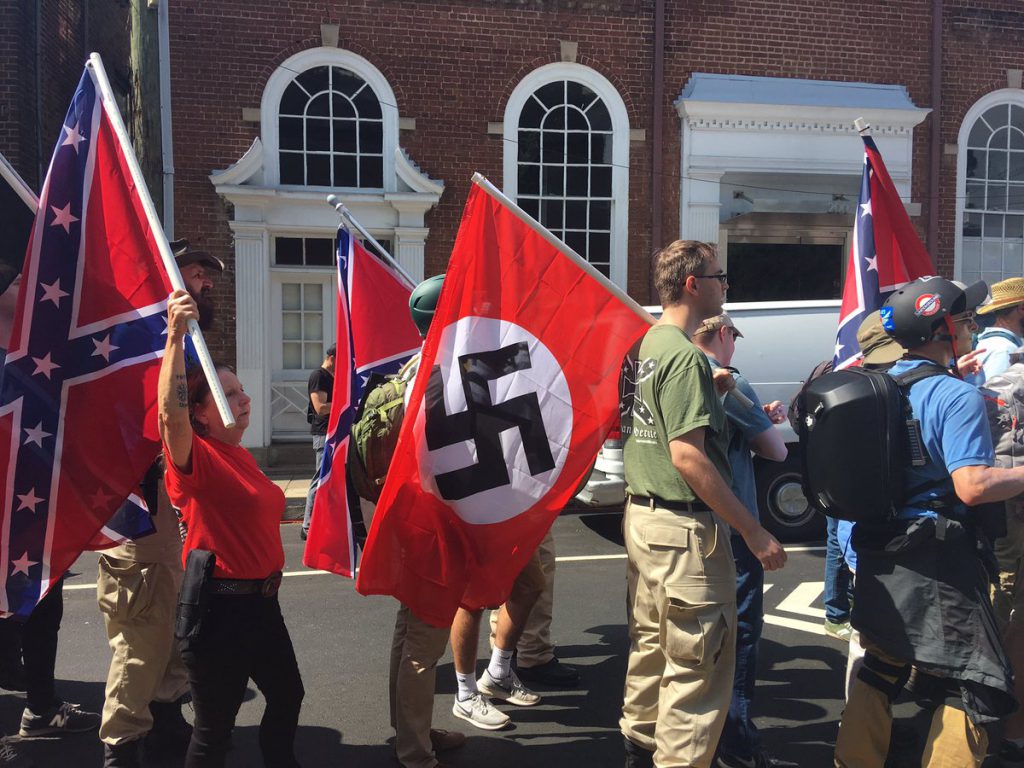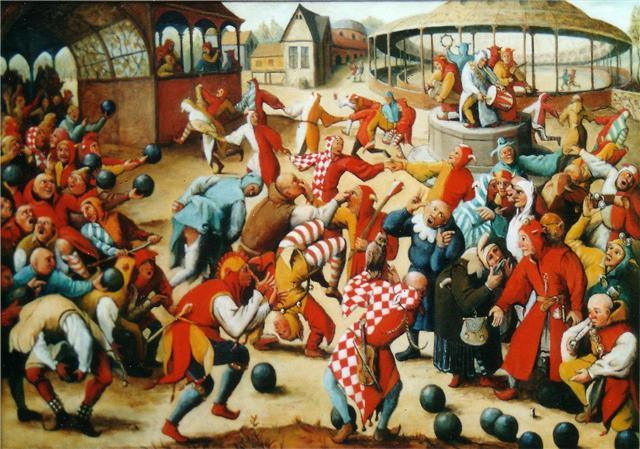Every now and then I run into right-wing rants about the prevalence of left-wing violence, in which the author genuinely believes that all Leftists (and minorities, who are presumed Leftists) are extremely violent people. It is a given on the Right that everyone but them is violent, which is why they have to be armed and prepared to shoot first.
In other words, the Right thinks it is entitled to use violence against the Left. The Right sees its own aggressive, intimidating violence as self-defense against whatever it is they think the Left might do.
For example, Dave Weigel wrote a few days ago that fears of the “violent left” preceded events in Charlottesville. Citing some incidents of property damage at the Inauguration and at Berkeley, the Right prepared for war.
In a Feb. 24 speech at the Conservative Political Action Conference, the National Rifle Association’s Wayne LaPierre linked those events with incidents of people being attacked if they supported the president.
“Right now, we face a gathering of forces that are willing to use violence against us,” warned LaPierre. “If the violent left brings their terror to our communities, our neighborhoods, or into our homes, they will be met with the resolve and the strength and the full force of American freedom in the hands of the American people. Among them and behind them are some of the most radical political elements there are. Anarchists, Marxists, communists and the whole rest of the left-wing Socialist brigade.” …
…In reality, antifa actions were relatively isolated, focused on disrupting white nationalist rallies — which, in turn, fed off the idea that the violent left needed to be stopped in the streets. Several high-profile rallies transformed into brawls between black-clad antifa and conservatives who sometimes claimed membership in new anti-antifa organizations, such as the Fraternal Order of Alt-Knights, a wing of the Proud Boys, itself a group founded by Rebel commentator Gavin McInnes.
If this leaves you perplexed, see history professor Yoav Fromer on why the American left gave up on political violence.
… despite what Trump has claimed, repeatedly, in his public statements since the tragic events there, the willingness to employ organized violence to achieve political goals remains a signature quality of only one side. And it’s not the left.
The professor says that while the American Left was never as given to revolutionary violence as in other parts of the planet, there have been times in U.S. history that leftist groups did attempt to achieve political ends through violent means. However, most of us realized some time back that this doesn’t work. First, it backfires (see the Bigger Asshole Rule). Nonviolent means achieve better ends. Also,
Emerging out of the rubble of the 1960s, the modern left, which coalesced around George McGovern’s quixotic 1972 presidential run, effectively represented a gathering of fugitives. African Americans, Hispanics, women, gay men and lesbians, Native Americans, and workers: These long-ostracized groups, which came to replace the New Deal coalition anchored by the white working class, were the very peoples against whom violence had been done for so long. Their painful histories made them instinctively averse to, and intolerant of, political violence. Those who had survived lynchings, beatings, bombings, sexual violence, forced removals and economic exploitation were least disposed to employ them in return.
In other words, people long victimized by right-wing violence are less likely than others to romanticize violence as a tool of righteousness. Do read the whole piece.
There’s another reason that lefties in the West have been less likely than righties to foment violence, and that is that the Left on the whole has been punished far more harshly than the Right for acting up. There is a terrible history in the U.S. of government-supported and sometimes government-perpetrated violence against racial minorities who engage in demonstrations, and white demonstrators have sometimes been victimized also — see the Kent State shootings.
Dan Berger, an associate professor of comparative ethnic studies at the University of Washington / Bothell, writes:
Klansmen, neo-Nazis and other assorted white nationalists described their descent on Charlottesville as a gathering to “Unite the Right.” Its bloody end, when one of them drove his car into a cluster of counter-demonstrators, killing one and injuring 19, was no aberration. Rather, murderous violence has been the through-line connecting four decades of efforts at uniting America’s far right. And such efforts have had a shocking amount of support from sectors of the U.S. government committed to “law and order.” Whether from law enforcement officials or the president, such support legitimizes the otherwise fringe politics of white nationalism and facilitates more racist attacks.
Law enforcement has been at the heart of the government’s uneasy relationship with white supremacist groups since the 1960s. Alabama Sheriff Eugene “Bull” Connor is but the most infamous in a long line of blustery law enforcement officials who aided violent attacks on black communities and left-wing activists. While Connor incited segregationist mobs to act, other police officers merely turned away when they did.
It was not just Southern sheriffs, either. For years, J. Edgar Hoover refused to act to prevent attacks on civil rights activists when his informants warned him such assaults were imminent. Worse still: FBI informants participated in such attacks. Gary Thomas Rowe was a paid informant for the FBI when he rode along with the carload of people who shot and killed activist Viola Liuzzo, a white mother of five from Detroit who had traveled to Selma in support of the civil rights demonstrations there. After her death, the FBI director tried to discredit her by telling President Lyndon Johnson and Attorney General Nicholas Katzenbach that Liuzzo had “indications of needle marks in her arms” and “was sitting very, very close to the Negro in the car” she was traveling in when the Klan attacked her.
In 1979, leftists organized a rally in North Carolina to protest right-wing paramilitary groups across the state:
Calling itself the United Racist Front, a caravan of Klansmen and neo-Nazi groups from throughout the state descended on the rally. The men parked their cars, calmly removed weapons from their vehicle trunks and opened fire.
Newscasters captured 88 seconds of carnage as armed racists gunned people down in the street. When they stopped firing, five leftists lay dead: Cesar Cauce, Michael Nathan, William Sampson, Sandra Smith and James Michael Waller. In their 20s and 30s, the dead were union organizers, doctors and committed antifascists. Another 12 people were wounded, some paralyzed for life.
Subsequent investigations revealed how thoroughly involved police agents were in what became known as the “Greensboro massacre.” Two paid police informants were involved in planning the attack, while others refused to intervene to stop the imminent bloodshed. One of the informants, Klansmen Eddie Dawson, played an instrumental role in partnering with the neo-Nazi National Socialist Party of America. Dawson also led the caravan that attacked the demonstrators.
The local police department knew of Dawson’s role and the likelihood for violence. Yet according to the 2006 report by the Greensboro Truth and Reconciliation Commission, police did not warn demonstrators that the white supremacists planned to attack them. Police officials directed their officers to stay away from the rally and not intervene before, during or after the attack. The Bureau of Alcohol, Tobacco and Firearms and the FBI had been monitoring the neo-Nazi groups but also declined to intervene. In fact, the ATF had their own informant in the neo-Nazi group who participated in planning the attack.
Although state and federal charges were brought against some of the shooters, all were acquitted. The New York Times reported in 1984:
”Praise the Lord,” said Jack W. Fowler Jr., an ex-Nazi Party member from Winston-Salem who hugged his wife after the verdict was announced in Federal court about 5:10 P.M. Other defendants wept, and one, Roland Wayne Wood, also an ex-party member, knelt on the courtroom carpet.
Dale Sampson, 35 years old, the widow of William Sampson, who was shot to death at the Nov. 3, 1979, rally, also wept. ”This is a real go-ahead for the Klan and Nazis to kill people,” she said.
Dan Berger doesn’t mention abortion clinic violence, so I will. It has struck me for a long time that government generally hasn’t taken such violence as seriously as it might have if the target were something other than abortion clinics — banks, for example. Operation Rescue and other groups have operated way too long under the protection of right-wing politicians who encourage murder and bombings with winks and nods.
But what about the much-reviled antifa? Paul Waldman wrote,
Yes, there are a small number of antifa counterprotesters who show up to scuffle with white supremacists when the latter mount a protest (if you’re unfamiliar, historian Mark Bray explains what antifa is). And yes, there have been other incidents, such as at Trump’s inaugural, in which antifa activists committed acts of vandalism. But the far right is 1) large; 2) highly organized; and most importantly, 3) directly tied to the president of the United States and the Republican Party.
Antifa is none of those things. It is tiny, not organized on a broad scale, and has precisely zero ties to any prominent Democrat. The president of the United States and leader of the Republican Party is celebrated and endorsed by the white supremacist right (“Thank you President Trump for your honesty & courage to tell the truth about #Charlottesville & condemn the leftist terrorists in BLM/Antifa,” tweeted David Duke Tuesday); the extreme left views Democrats as an enemy. Trump directly echoes and repeats the arguments and claims of the extreme right, as we saw him do on Tuesday; no elected Democrat shares the radical anti-capitalist ideas of the extreme left. Trump hired Stephen K. Bannon, who ran the white nationalist website Breitbart, which Bannon himself described as “the platform for the alt-right,” to run his campaign and then to be senior adviser in his White House.
Again, we see that the thugs on the Right have connections to government authority and power; perpetrators of violence associated with the Left do not. And, there is simply no equivalence between antifa and the Klan/Nazi extremists in the dangers they pose:
Still, their [Antifa’s] numbers are tiny in relation to the mainstream political left. And, say experts, it’s misleading for right-wing groups to suggest that the Antifa are more violent than right-wing extremists.
“The far left is very active in the United States, but it hasn’t been particularly violent for some time,” says Mark Pitcavage, a senior research fellow at the Anti-Defamation League’s Center on Extremism.
He says the numbers between the groups don’t compare.
“In the past 10 years when you look at murders committed by domestic extremists in the United States of all types, right-wing extremists are responsible for about 74 percent of those murders,” Pitcavage says.
You have to go back to the 1970s to find the last big cycle of far-left extremism in the U.S. Both Pitcavage and McNabb say we have been in a predominantly far-right extremist cycle since the 1990s — the abortion clinic bombings and Oklahoma City, for example. And, more recently, racially motivated attacks such as the one at a Sikh temple in Wisconsin, the mass shooting at a black church in Charleston, S.C., and last month’s stabbings on a commuter train in Portland.
Right-wing terrorism in the U.S. has been around at least since the nativist Know Nothings engaged in anti-immigrant riots and torched Catholic churches in the 1850s. The original Ku Klux Klan was founded in 1866 and was responsible for countless lynchings, shootings and deadly race riots. In a break from the usual pattern, President Ulysses S. Grant used federal troops to crush the Klan. But this outraged southern whites and many northern whites as well. After Grant, the government went back to averting its gaze from racial atrocities.
Historically, right-wing violence punches down. Left-wing violence punches up. Back to Yoav Fromer:
Labor unions battled constantly with railroad barons, industrial tycoons and mining bosses during the Gilded Age. Even while outnumbered and outgunned, usually by private armies that enjoyed the backing of law enforcement and state militias, workers fought in bloody clashes that left dozens dead on battlefields such as Chicago’s Haymarket Square (1886) and West Virginia’s Blair Mountain (1921).
More recently, some on the fringes of the 1960s New Left, such as the Weather Underground, were known for fomenting violence. But since the 1970s, as many have said, the Left generally has been committed to nonviolent protests. James Hodgkinson, the shooter who opened fire on congressmen at a Virginia baseball field, was an anomaly who was not working with any other group. I’m not aware of any left-wing group condoning what he did.
Right-wing militias, on the other hand, are surging. They are organizing, recruiting, arming themselves and training for violence. “There are more than 500 militia groups in the U.S., more than double the number in 2008, according to the Anti-Defamation League. Most of them are right-wing and anti-government. Most of them harbor a toxic soup of shared delusions about how leftists and minorities are out to get them.
Lefties think they are demonstrating against oppression; righties think they are at war.
I am utterly opposed to matching right-wing violence with left-wing violence. It doesn’t settle anything, and history has taught us that the Left will suffer a disproportionate degree of punishment for it. That’s not a game we can win, frankly. I do think swamping them (nonviolently) with overwhelming numbers, such as what happened this weekend in Boston, is much more effective and might shake some of them out of their delusions.
Beyond that, I don’t have much advice except to stay strong and don’t get killed.



